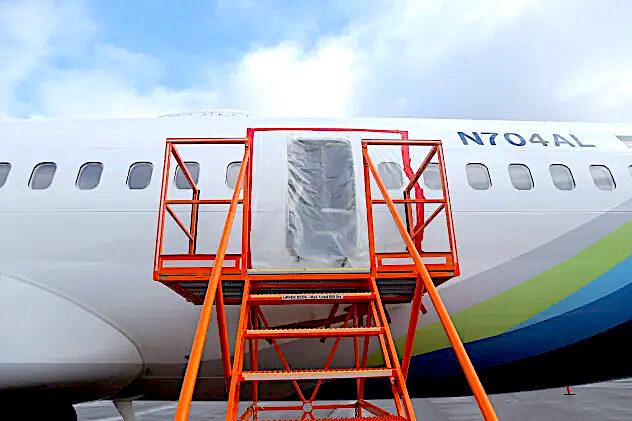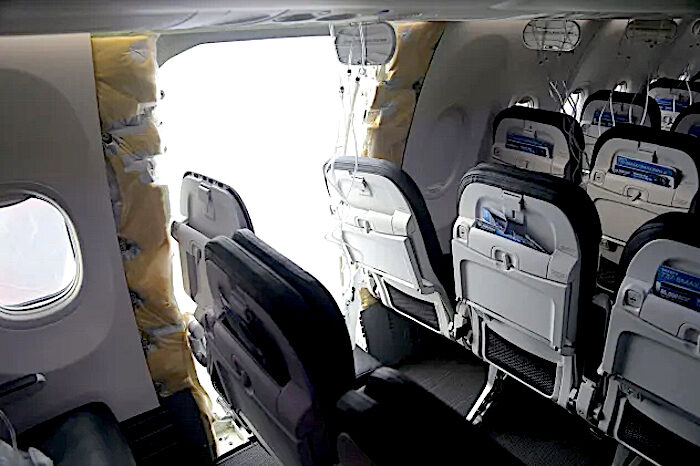
A Portland schoolteacher named Bob found the refrigerator-size Boeing 737 MAX 9 fuselage door plug in his yard and reached out to the National Transportation Safety Board, NTSB Chair Jennifer Homendy said at a news conference Sunday night.
The plug door had been missing since it blew off an Alaska Airlines aircraft Friday, leaving a gaping hole on the side of the plane as it flew at 16,000 feet shortly after taking off from Portland. The harrowing ordeal - which saw headrests ripped off and items sucked from the cabin - has led to the nationwide grounding of certain Boeing 737 MAX 9 aircraft and a slew of flight cancellations.
"It must have been a terrifying event to experience," Homendy said Sunday after seeing the chaotic aftermath of the plane's interior, which included damage in several rows.
As the investigation moves into its second day, NTSB officials will continue to painstakingly examine the interior of the plane and begin plans to recover and examine the detached door plug, Homendy said.
Complicating efforts is the loss of critical cockpit audio recordings because of a device setting, according to Homendy.

"It must have been a terrifying event to experience," Homendy said Sunday after seeing the chaotic aftermath of the plane's interior, which included damage in several rows.
As the investigation moves into its second day, NTSB officials will continue to painstakingly examine the interior of the plane and begin plans to recover and examine the detached door plug, Homendy said.
Complicating efforts is the loss of critical cockpit audio recordings because of a device setting, according to Homendy.
Plane was restricted from flying over water amid auto pressurization fail lights
Alaska Airlines had restricted the plane from flying from over the ocean to Hawaii to ensure the plane could "return very quickly to an airport" in case any warning lights in the aircraft went off, according to Homendy.
The decision came as the plane's auto pressurization fail light had illuminated three times in the past month, Homendy said, noting it is unclear if there is any correlation between the warning lights and the Friday incident.
The fail light came on December 7 and on January 3 and 4 -- the days leading up to the blowout, she said. Each time, the flight crew flipped a switch to the system's backup, Homendy said, describing the move as "very normal."
"They flipped it, they reported it, it was tested by maintenance and then reset. They did order additional maintenance to look at the light that was not complete before (the fuselage blowout). We plan to look at that more and we've requested documentation on all defects since delivery of the aircraft on October 31."CNN has sought comment from Alaska Airlines on the plane's flight restriction and warning lights.
The Boeing 737 Max 9 involved in Friday's incident had been in service for about three months and has flown about 150 times since October 2023, according to FlightAware and FAA records.
Crew interviews, interior damage illustrate terrifying scene
Interviews with flight crew members and the examinations of the damage left behind inside the cabin shed light on the loud, "violent" and chaotic scene inside the aircraft when the plug door tore off, causing an incredibly forceful depressurization and sending flight attendants rushing to the side of children on the flight, the NTSB chief said.
After the "explosive event," flight attendants scrambled to ensure four unaccompanied minors onboard were wearing oxygen masks and lap belts, Homendy said, praising the attendants as "heroic."
But "communication was a serious issue" between the pilots and flight attendants, who said they were having difficulty quickly sharing information, she added.
"I do want to emphasize that the actions of the flight crew were really incredible," she said.
The impact of the event caused damage to the interior paneling, trim and plastic around the windows inside the plane, all of which are "not critical" to the aircraft's structure, Homendy said.
The damage extended to several rows on the plane - not just the row next to the hole, according to Homendy.
The two seats next to the door plug - 26A and 26B - were empty when the blowout happened, but had their headrests torn off, she said previously. The back of 26A is completely gone.
There was no structural damage to the aircraft and airframe, she noted.
Alaska Airlines has said it is working with Boeing to understand what happened on Flight 1282.
Cockpit recorder setting wipes crucial evidence
The cockpit voice recorder, which captures sounds such as engine noises and pilots' voices, was "completely overwritten," since devices are currently only required to retain two hours of audio at a time, Homendy said.
"There is nothing on the cockpit voice recorder," she said, noting the maintenance team went out to get the recorder around the two-hour mark when the devices begin a new recording cycle.
The audio captured by the recorders is "critical" to helping investigators understand what occurred during the incident, Homendy said. Without it, there is no record of communications between pilots and flight attendants as the crisis was unfolding.
"If that communication is not recorded, that is, unfortunately, a loss for (the NTSB), and a loss for the FAA and a loss for safety because that information is key not just for our investigation, but for improving aviation safety," Homendy said.
Though the FAA has proposed a new rule that would require new aircraft to extend their cockpit voice recordings to 25 hours, the rule would not require older aircraft to be retrofitted, Homendy noted. The NTSB chief called on the FAA and Congress to require 25-hour recordings in all aircraft.
"I cannot emphasize enough how important that is for safety," she said.
CNN has sought comment from the airline on the wiped cockpit audio.
Fallen cell phones may provide insight
Two cell phones that were likely flung from the plane were found in a yard and on the side of a road and turned in to investigators, who may be able to use them as evidence, Homendy said.
"Cell phones have actually helped us determine some things that occurred after tragedies ... But it also helps in telling us, 'Are we looking in the right area?," the agency chief said just minutes before finding out the door plug had been discovered.
Sean Bates told CNN he spotted a phone on an Oregon roadside and turned it over to the NTSB, who were already in the area investigating the accident.
The phone didn't have a security lock, and a photo of the phone shows an emailed Alaska Airlines baggage receipt for two bags, Bates said.
NTSB spokesman Jennifer Gabris told CNN that the agency took custody of the phone Sunday and has since turned the phone over to Alaska Airlines.



Comment: Boeing acknowledges mistake after mid-air blowout on Alaska Airlines Flight 1282: Boeing stock down: See also: